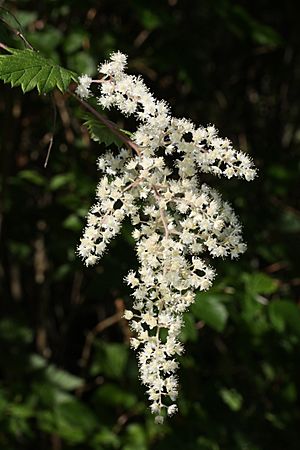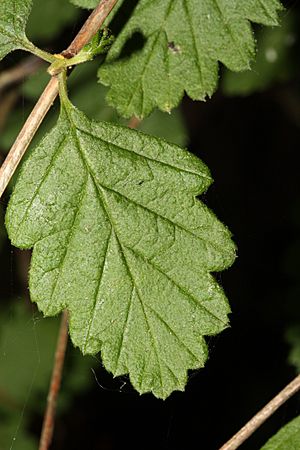Ocean spray facts for kids
Quick facts for kids Ocean spray |
|
|---|---|
 |
|
| Holodiscus discolor flowers (Anacortes, Washington) | |
| Scientific classification | |
| Genus: |
Holodiscus
|
| Species: |
discolor
|
Holodiscus discolor, commonly known as ocean spray or oceanspray, creambush, or ironwood, is a shrub found in western North America. It gets its name "ocean spray" from its clusters of white flowers that look like sea foam.
Contents
Where Does Ocean Spray Grow?
This plant is very common in the Pacific Northwest and all over California. You can find it in many different natural places, like California mixed evergreen forests, California oak woodlands, and chaparral. It also grows in Coast redwood forests and various Douglas-fir and pine forests.
Ocean spray grows in areas from about 1,000 to 4,200 feet (300 to 1,300 meters) high. It likes both moist forests near the coast and drier, cooler mountain areas inland. This plant is often one of the first to grow back after a wildfire. It's common in chaparral areas, which are ecosystems that have evolved with regular fires. You might also see it growing in places where trees have been cut down by logging.
What Does Ocean Spray Look Like?
Ocean spray is a fast-growing deciduous shrub, which means it loses its leaves in the fall. It usually grows to be about 4 to 5 feet (1.2 to 1.5 meters) tall, but it can reach up to 7 feet (2 meters). Its leaves grow alternately along the stem. They are small, about 2 to 3.5 inches (5–9 cm) long and 1.5 to 2.7 inches (4–7 cm) wide. When they are new, they are a bright, juicy green and have a lobed shape.
The plant gets its common names from its beautiful, drooping clusters of white flowers. These flower clusters hang down from the branches, looking like a spray of water. The flowers have a light, sweet smell. Ocean spray usually blooms from May to July.
After blooming, the plant produces small, fuzzy fruits. Each fruit holds one tiny seed. These seeds are very light, so the wind can easily carry them to new places to grow.
How People Use Ocean Spray
For a long time, Indigenous peoples have used the ocean spray plant in many ways. They would eat the raw or cooked seeds. Sometimes, they mixed the leaves with other plants and boiled them with small game animals for food.
The wood and bark of the ocean spray plant were very useful for making tools and furniture. Its wood is known for being strong. Because of its strength, it was often used to make digging sticks, spears, arrows, bows, harpoons, and even nails. To make the wood even harder, people would often use fire to strengthen it. Then, they would polish it using plants like horsetail.
The Comox people, a First Nations group, use the flowering of ocean spray as a sign. When the plant is in bloom, they know it's the best time to dig for butter clams.
Traditional Health Uses
Some Native American tribes used ocean spray for health purposes. The Lummi people, for example, used the flowers to help with diarrhea. They also used the leaves as a poultice, which is a soft, moist mass applied to the body to relieve pain or swelling.
Other tribes, like the Stl'atl'imx, would soak the berries in hot water. They used this liquid to help treat diarrhea, smallpox, and chickenpox. It was also used as a "blood tonic," which means it was thought to improve overall health.
Important for Nature
Ocean spray is very important for local wildlife. It's a special plant for pollinators like native bees and butterflies, providing them with food. It's also a host plant for several types of caterpillars. This means that butterflies like the Lorquin's admiral, pale tiger swallowtail, and spring azure lay their eggs on ocean spray leaves. The caterpillars then eat the leaves as they grow.


